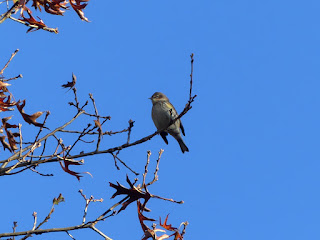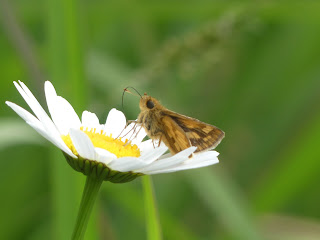Yellow-rumped Warbler
Here's a fairly well-known bird that I don't often get a picture of: the Yellow-rumped Warbler. You can actually see their famous yellow rump in the second picture. These birds mostly visit us in the winter, taking advantage of our (relatively) balmy winters (compared to their breeding range that can go pretty far north into Canada).
The Yellow-rumped Warbler may not be a species soon, and this gets to the heart of what we consider a species to be. Prior to 1973 our eastern population of Yellow-rumped Warblers was called Myrtle Warblers [1], and another western population was called Audubon Warblers [2]. But then it was discovered that these 2 populations were interbreeding very readily in one range overlapping area, and so in 1973 they were grouped together into 1 species, the Yellow-rumped Warbler.
But ornithologists have continued to study these birds, and have concluded that while the birds in the overlapping range have a mix of DNA between the eastern/western populations, that mix of DNA doesn't seem to spread out. This suggests that the birds with the eastern genes don't do well in the west, and the birds with the western genes don't do well in the east, which supports the idea that these are better thought of as 2 species that hybridize rather than 1 species with different forms.
So it's possible that Yellow-rumped Warbler will be retired as a species, mostly replaced by the Myrtle and Audubon Warblers. (It's likely that a small isolated population in Guatemala will also become a separate species. It's less clear what would happen to another isolated population in Mexico.)
To me, this also points out the limitations of our taxonomic model. Nature isn't really about distinct buckets that all life fits into, but is really about varying levels of relatedness. Nature actually works more like fuzzy logic than boolean logic. Maybe we shouldn't answer the question: Is this a Myrtle Warbler with a yes/no, but with a 85% (or some similar percentage).
 |
| November 3, 2021 at Duke Farms Photo 168431490, (c) jpviolette, some rights reserved (CC BY-NC) |
 |
| November 3, 2021 at Duke Farms Photo 168431511, (c) jpviolette, some rights reserved (CC BY-NC) |
[1] They got their name from their rare ability to digest bayberry and other wax-myrtle berries.



Comments
Post a Comment